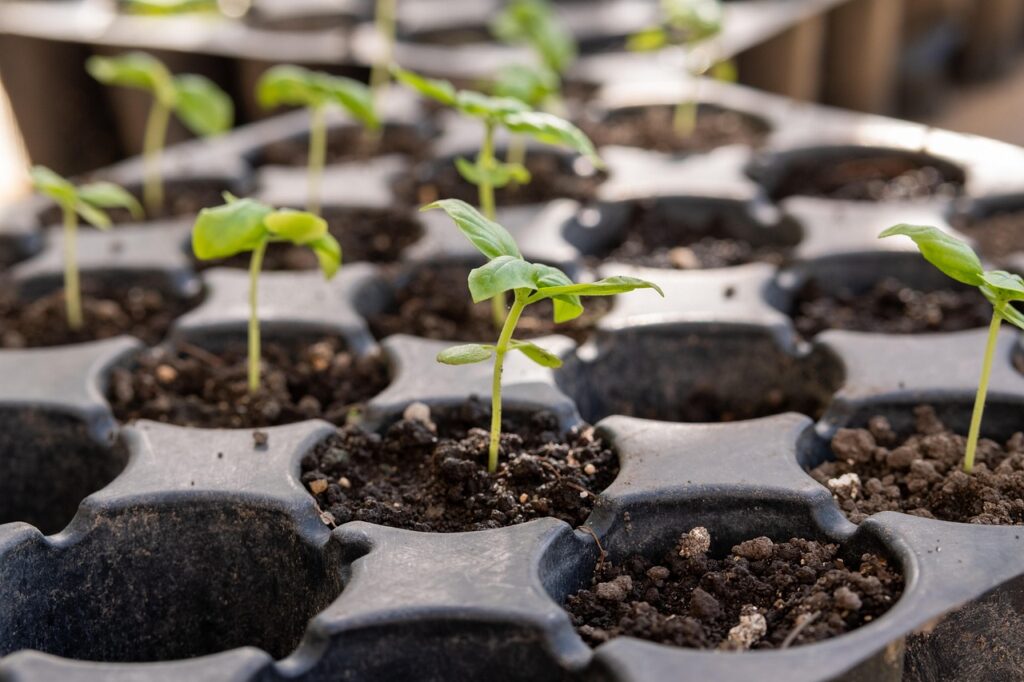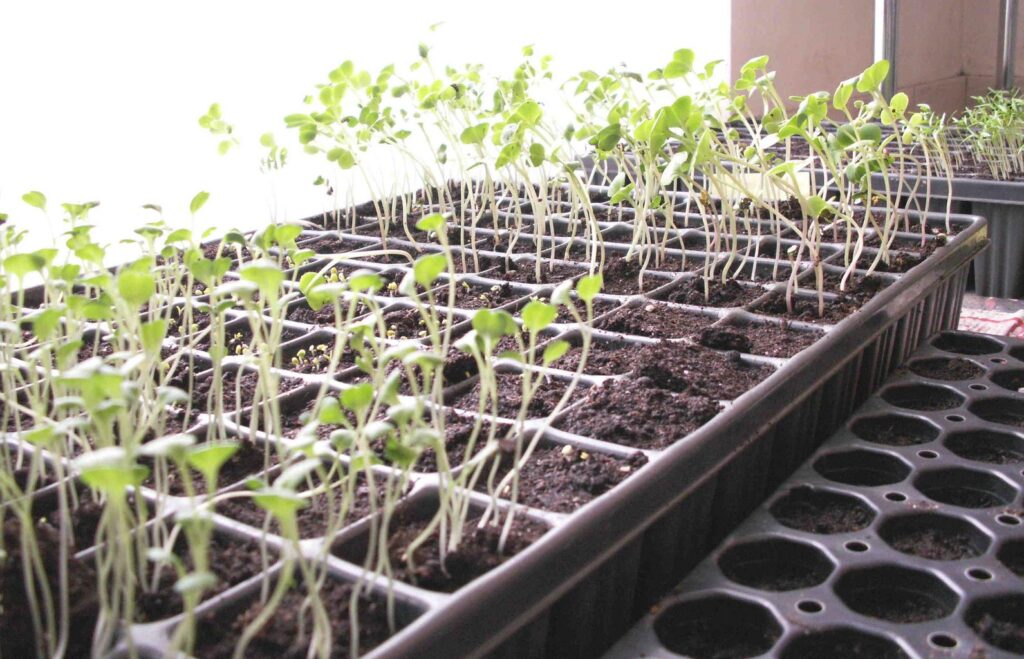If you’re a vegetable gardener, you know how important it can be to get your crops into the garden as soon as possible in the spring to ensure a good harvest and beat the bugs.

Just like all facets of gardening, seed starting is a lot of science and a little art, and there’s no shortage of products and materials on the market to make your seed starting efforts more successful. One of those essential materials is a seed starting mix, or a growing medium you can plant seeds into that will facilitate their growth.
There are tons of types of growing media, potting mixes, seed starting mixes, soil and more at the garden center. How do we know what to choose? The first thing to know is that the mix you use to start seeds is going to differ from the mix you use in in-ground beds and even in planters and containers.
Seed starting mixes should be:
- Fine and uniform. Avoid big chunks that make a rough surface and can cover or block germinating seeds.
- Light and loose. Dense materials, like clay, pack together tightly and prevent water from draining and baby roots from being able to work their way through the medium. Seedlings need plenty of micro-spaces for air around their roots. They don’t like to sit in heavy, dense, or wet soil for long.
- Free of weed seeds, insects, and diseases. Steer clear of soil from your garden, which can contain all three. Seed starting mix contains no real soil and is sometimes called soilless medium.
- Low in fertility. Seeds themselves contain all the nutrients that baby seedlings need to start their growth. Too much fertilizer can burn seedlings’ fragile roots and increase the growth of fungal diseases, like damping off.
Bagged potting soil or soil straight from the Georgia garden is going to be too dense, too rich with nutrients, and will probably contain weed seeds, diseases, and insects that you don’t want interfering with your seedlings’ growth.
Of course, you can purchase premade seed starting mixes off the shelf at the garden center. One downside is that they are usually sold in small quantities (8-12 quarts is pretty standard), and this may not be enough to supply all the trays you plan to seed. While not that expensive per bag, the cost adds up if you’re seeding a large quantity of trays or are starting seeds and buying new mix every year. One solution is to make your own DIY seed starting mix for a fraction of the per unit cost!
Use this basic recipe to make your own seed starting mix:
- 1 part peat moss or coconut coir
- 1 part vermiculite
- 1 part perlite
What do these ingredients do?
Peat moss and coconut coir soak up water like a sponge. Peat moss, also known as sphagnum moss, can store a huge amount of water inside its cells. It is mined from peat bogs and wetlands around the world, which act as a carbon sink. The destruction of these wetlands contributes to climate change. One alternative, coconut coir, is made from the discarded husks of coconuts and so is a much more sustainable option but is less readily available at garden centers.
Vermiculite is a naturally occurring mineral made of magnesium, aluminum, and iron. It is mined and sold as small, brown pellets or flakes. Like coconut coir and peat moss, vermiculite’s function is to hold onto water. But, because of its shape, it also aerates soil and allows water to drain through.
Perlite is the crumbly, Styrofoam-looking material you see in bagged potting mix. It’s actually made from volcanic glass that’s heated to superhigh temperatures, causing it to puff up like popcorn. Adding perlite to your seed-starting mix improves drainage and keeps the mix nice and loose, allowing your seedling’s roots to get plenty of oxygen and grow with ease. For seed starting mix, use ‘fine’ perlite, as coarser particles can act like roadblocks to your growing seedlings.
If you have leftover ingredients, they can all be used for container plants or saved for seed-starting next year.

How to make seed starting mix at home
- It’s easy – add all three ingredients to a bucket in equal quantities and mix well until all ingredients are evenly distributed.
- Perlite is extremely lightweight and dusty, so I recommend wearing a surgical mask when scooping or dumping it from the bag.
- Water the mix until moist but not sopping. Then you’re ready to scoop into your plug trays or pots. Once you’ve distributed your seed starting mix into your container of choice, avoid pressing it down or compressing it. Loose mix allows seedlings’ roots to grow without any obstacles.
- Different brands of ingredients will dry out at different rates, so keep an eye on your trays or containers and make sure they stay moist (but not too wet!) until your seedlings sprout.
Alternative recipes
Some gardeners include compost in their seed starting mix. Active microbes in compost contribute to a diverse soil ecosystem and may help combat seedling diseases. On the flip side, compost can also introduce microbes that may actually cause seedling diseases.
Many greenhouse growers swear by only vermiculite as a seed-starting medium. It holds onto moisture but allows good drainage, and it doesn’t contain anything that would introduce microbes or pathogens.
Rice hulls are a more sustainable alternative to perlite, which is a mined, non-renewable material. However, they are a little harder to come by than perlite, which you can find at any garden center.
If you’re starting seeds at scale, making your own seed starting mix is an economical option! Whatever materials you choose, make sure your mix is fine, loose, and free of pests, and you’re off to the races.
If you have questions about starting seeds this spring, feel free to contact your local county Extension office.